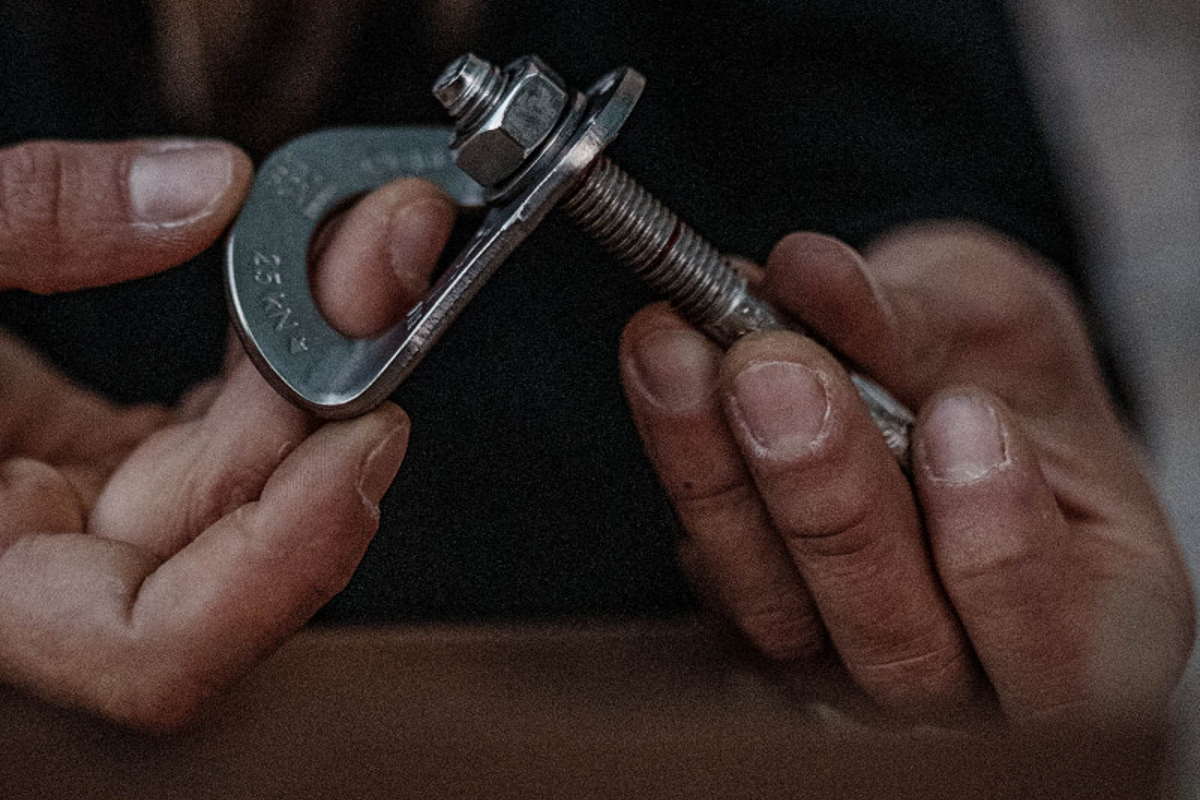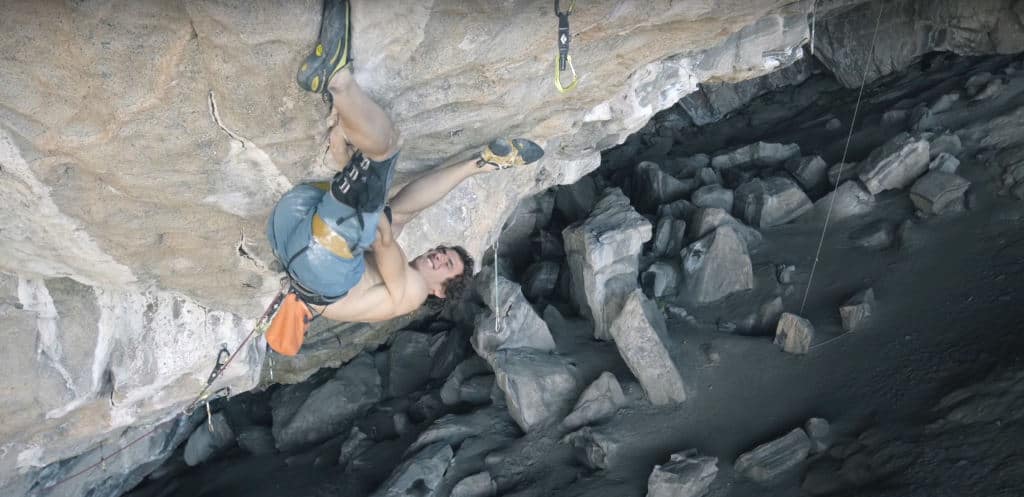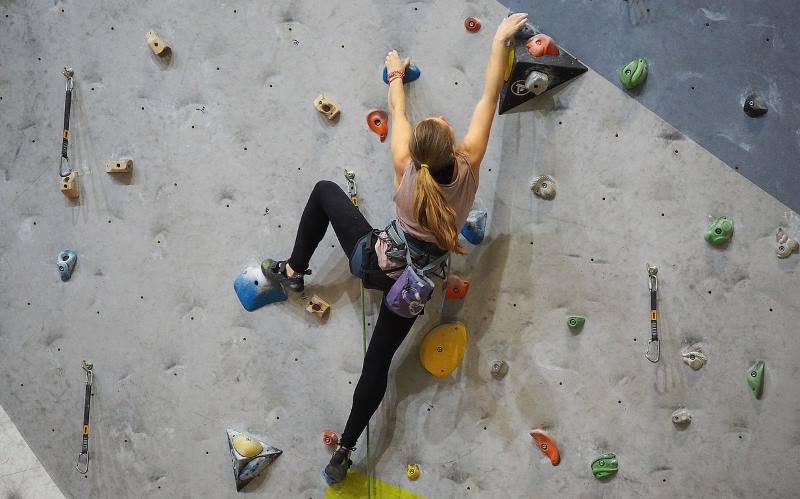You might have seen people “free climbing” a big route in the news and it sounds about as dangerous as it gets. The term actually means something slightly different than what most people would expect. Let us break it down for you!
What Is Free Climbing?
Free climbing means climbing using hands and feet to get up but using a rope, harness, and protection on the wall just for safety. Basically, the gear is only there to clip the rope into and catch you if you fall – not to help you pull up on the route.
Free climbing doesn’t mean climbing without a rope or safety gear. That’s called free soloing. We use the term free climbing to differentiate from using the gear to actually help you get up the wall – normally called aid climbing.
What Does It Mean To Free Climb Something?
To free climb a route means you climbed the entire thing using your skills and strength – only using the gear to stop a fall. The only gear you can use to help you climb is a pair of climbing shoes and some chalk.
The safety gear is a harness tied in to a special climbing rope, the other side being managed by your “belayer” or climbing partner below. Climbers clip the rope into bits of protective gear on the wall. If they fall they are caught on the rope – which is just there for safety, not as a hoist.
Free climbing a route is commonly called “freeing” a route. So if someone says they free’d something it means they did use a rope and safety gear but climbed the actual route with their own hands and feet. It also generally means you climbed a route “clean” from bottom to top.
Types Of Free Climbing
Sport climbing and trad climbing are the most common types of free climbing. Both are done with different ways of protecting from a fall and very different mindsets.
Trad Climbing
In trad climbing – aka traditional – you use devices like cams, hexes, and nuts that are wedged or placed into seams in the wall. Different routes take different protection. Climbers either take a variety of different types and sizes or find out what pieces to take from friends or guidebooks.
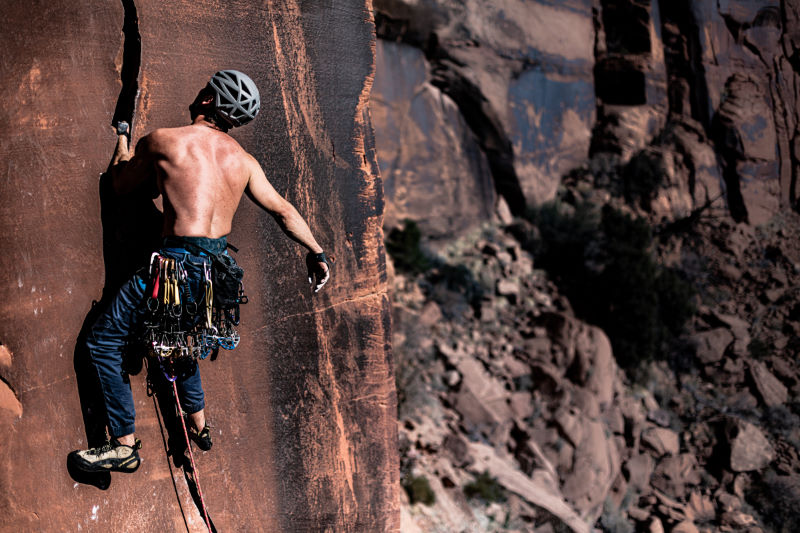
This is obviously the more traditional way of climbing and takes a lot longer than sport climbing. Stopping to place a piece, check it’s in right, then clip in the rope all take time. It has the advantage of not needing to drill and leave visually obvious bolts in the wall but can leave some scarring on certain rock.
Falls are in general avoided as much as possible. Gear can and does pull out of the rock – even multiple pieces, leading to ground falls. Trad climbs can have very few places to put protection so can lead to large runouts. The UK Trad grades even have one grade for difficulty and one for the danger of a fall.
Sport Climbing
The more modern form of climbing that’s more focused on athletic and physical ability. In sport climbing bolts are drilled into the rock which allows the rope to be clipped in. Falling on a bolt is considered very safe as they very rarely fail.
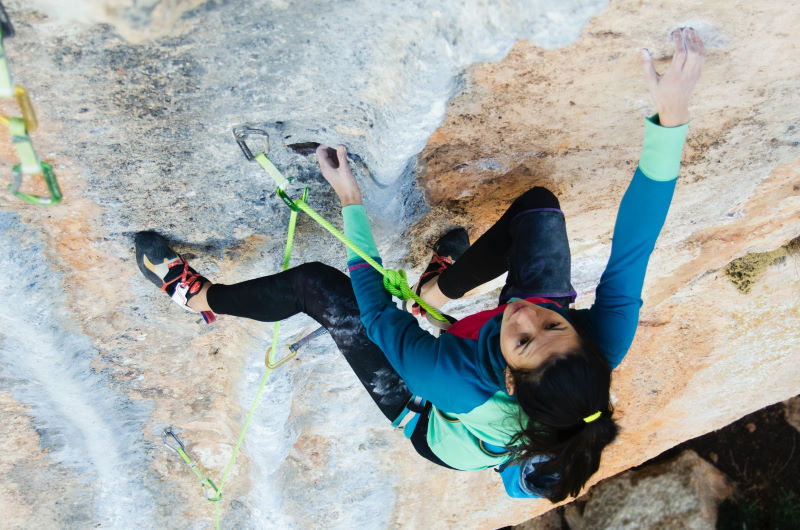
The hardest climbing routes are all sport because they allow for falling over and over again without much safety concern. You can sport climb indoors or out but trad climbing is basically limited to the outdoors. It’s an easier, more accessible, and cheaper way to rock climb.
The bolts and lowering anchors can be seen so some people are against them because of the visual impact. Sports areas tend also to draw in a lot more foot traffic and can lead to erosion, waste/trash in the area, and access issues.
Learn more
– What Is Sport Climbing?
– What Is Trad Climbing?
– What Is A Carabiner?
What Does Climbing A Route “Clean” Mean
If you fall while on a route you can carry on climbing from where you were but it wouldn’t be a clean ascent. Climbing a route clean means you did it without falling at all from bottom to top.
Pulling on a quickdraw, cam, a bolt, or the rope would mean it wasn’t a clean ascent. Resting with your weight on the rope isn’t OK but resting with your weight on a ledge or in a kneebar is fine.
If you do fall on the route you can lower to the bottom, pull the rope through, then try it again to get it clean. There are a few different terms for the exact way you climbed something – either onsight, flash, or redpointing.
Why Is It Called Free Climbing?
The term free climbing or to free a route became needed when the style of climbing became more widespread. Many classic big wall routes were done with different amounts of aid to help the climbers up.
As climbers got stronger and refined their technique, gear was also getting lighter and safer. During the 60s and later – especially in America – many of the older routes that had only been climbed with aid started to be climbed entirely by hand with safety equipment purely to stop falls.
This started to be called free’ing a route. Many of the world’s most famous routes had been completed only 10 or 20 years before with a mix of aid and free climbing. The parts of them which have been done with aid had been sometimes been deemed impossible by the first creationists.
As young climbers started to free these big classics – it set the climbing world alight. The ceiling of difficulty had just been shattered and the new trend was to free climb everything.
Over the next 20-30 years came a radical shift in what was considered possible. Changes included the common use of chalk, the first sticky rubber climbing shoes, specific climbing training and the entire sport of bouldering, modern bolts, ropes, carabiners, and a massive rethink on the ethics of climbing.
Probably the most famous example of an “impossible” aid route getting free’d was when Lynn Hill free climbed the Nose on El Capitan in 1993. The phrase “It goes, boys” sent ripples through the community. To quash all doubters she came back and did it just one day, one year later. Watch Lynn Hill on the Nose.
What Is Aid Climbing?
Aid climbing is climbing a wall however possible, using whatever gear or methods are available. Modern aid climbing tends to go for minimally damaging gear like cams and nuts, small and tailored hooks or beaks, and uses “aiders” to walk up the wall.
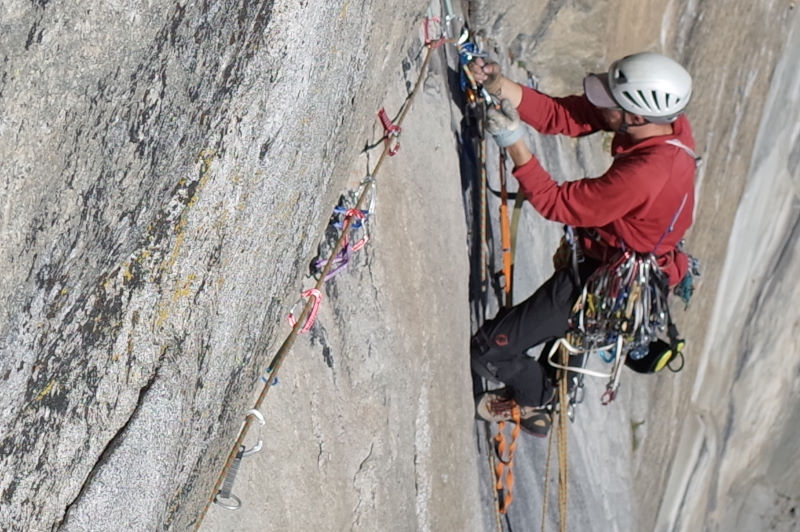
Way back in the days of traditional alpinism, the gear would be pretty sparse. Originally you’d use a hammer to pound metal pitons into cracks and seams in the wall. Even wooden block wedges were used and most gear was homemade.
These days aid climbing is less practiced and free climbing – either sport climbing or trad climbing – is the most popular method. Aid climbing is still very common on big walls like in Yosemite.
Big wall climbing normally refers to a mix of aid and free climbing but can be done in a free climbing style – see the Dawn Wall. It involves sleeping on the wall using portaledges, and requires a lot of knowledge and problem-solving. Hauling gear and working out the logistics is half the “fun” of big walls.
Difference Between Free Climbing And Aid Climbing?
Aid climbing uses gear that you can pull on, step into, or otherwise use to get yourself up the wall. The gear protects from falls too. In free climbing like sport or trad the gear is just used for protection from falls and to help with lowering down.
Do Free Climbers Use A Rope?
Yes, free climbing uses a rope, harness, and protection in the wall to protect from falls. You’re probably thinking of free solo climbing described below.
What Is Free Climbing Vs Free Soloing
Free solo climbing means climbing without any form of protection from a fall. Free climbing uses protection, free solo climbing doesn’t. Climbing shoes and chalk are the only bits of gear free solo’ists use. Without the rope, harness, or any safety gear it means a fall can be fatal or cause serious injury.
You might know the most famous free solo climber of all time already – Alex Honnold. If you’ve seen Free Solo or live/work with anyone who’s ever been to a climbing gym you may have heard about the guy who climbed the 3,000 ft El Capitan formation in Yosemite without a rope. If you haven’t seen Free Solo it’s absolutely worth a watch.
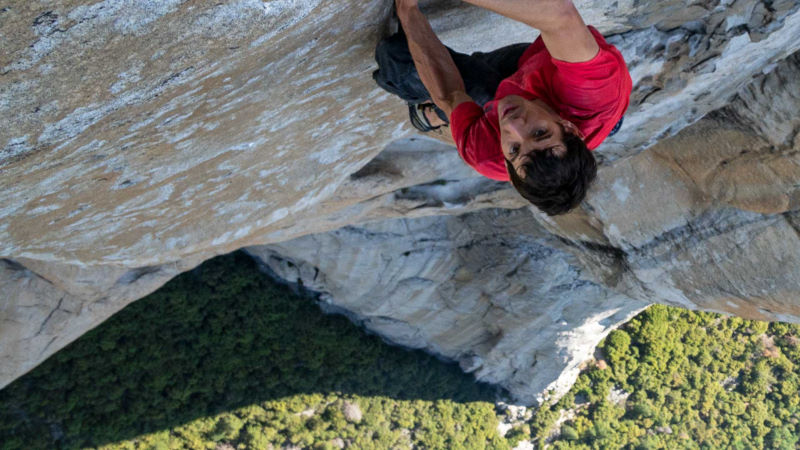
The term free solo comes from doing the climb free like we’ve defined above and solo as in on your own. Most climbers use the slang solo to mean someone climbed something free solo, without a rope. It’s possible to climb alone but with a rope – that is termed rope solo.
Free climbing isn’t free solo’ing, but free solo’ing is technically a form of free climbing – because it’s done without aid.
Types Of Rock Climbing
Confused? Here are a bunch of different types of climbing all the way from walking to climbing without a rope. Bear in mind the terms evolved to try and differentiate things at the time they were happening. Some extra helpful terms are thrown in.
- Hill-Walking – Walking up hilly areas – the least strenuous form of mountain exploring.
- Scrambling – Steeper, more rocky terrain where you’ll need your hands for balance. Falls can be dangerous depending on the area.
- Rock Climbing – Any form of climbing on rock steeper than a scramble, where a fall could result in serious injury.
- Aid Climbing – Climbing using gear placed into the wall that you pull on or step into. Originally involved pounding pitons into seams and cracks in a wall and clipping yourself to them to aid progress. Modern aid uses things like beaks and hooks that slip in or attach to small rock features.
- Free Climbing – You can place gear into the wall – usually more modern devices like cams and nuts that don’t damage the rock – but only to protect in case of a fall. You can’t use it to pull yourself up. More technical.
- Sport Climbing – Using fixed protection in a wall as you climb. Uses bolts and hangars drilled into the wall for good protection from falls – Read What Is Sport Climbing?
- Trad Climbing – Climbers put their own protection in the wall in the form of cams, nuts, beaks, or tricams. This protection is wedged into cracks and fissures in the wall and should hold in the case of a fall.
- Lead Climbing – Lead climbing is Sport Climbing. Lead refers to climbing with the rope on the ground and clipping it in as you go – Read What Is Lead Climbing?
- Top Roping / Seconding – Being belayed with a rope above you. Generally safer than leading and smaller, safer falls.
- Free Solo – Climbing without a rope, harness, partner, or any safety measures.
- Rope Solo – Climbing alone using a rope and special gear to progress without a partner. Slower and more dangerous than free climbing with a partner but much safer than free soloing.
- Big Wall Climbing – Climbing a big wall that probably involves an overnight stay in a portaledge. Can be done totally free, completely aid climbed, or a mix (more common).
- Bouldering – Low level climbing just a few meters up on actual boulders. No rope or harness, just a thick foam crash pad underneath to fall on – Read What Is Bouldering?
- Speed Climbing – Two climbers compete against each other for the fastest time on the same route – Read What Is Speed Climbing?
- French Free – Climbing a route but pulling on one or two bits of gear to help you up – Read What Is French Free Climbing?
- Hang Dog – Hanging on the rope to rest or practice moves.
Is Free Climbing Dangerous?
Yes, free climbing in all its forms is dangerous but at different levels. Free solo climbing can lead to death or serious injury with a simple slip. Free climbing like sport or trad is considered potentially dangerous. The main issues are user errors or complete accidents like rockfall.
Sport climbing is regarded as one of the safest forms of climbing. Bolts very rarely fail and the most serious injury is from rappelling accidents or incorrectly tied knots. Outside of those the main issues are awkward falls onto ledges, flipping upside down without a helmet, and general sprains and finger injuries.
Trad climbing is more dangerous because gear doesn’t always hold. Cams and nuts need a lot of experience for a safe placement. Considering the possibility of the fall, the angle and force of rope pull, the type of rock e.t.c are all important.
Gear does pull out and if one piece pulls then the next piece will likely take more force and can also then pull out. This can lead to a “zipper” where multiple or all pieces of protection fail – leading to a ground fall.
Are Speed Climbing Records Done Free?
Speed climbing ascents are usually anything-goes tactics. Watching Reel Rock 14 you’ll see Tommy Caldwell and Alex Honnold pulling on anything they have to hand just to get up the route faster.
Tactics include holding quickdraws in each hand and using bolts as a ladder, bumping a cam up a crack and pulling on it, clipping into other people’s anchors, and using foliage and trees to yank – it’s all in the game.
